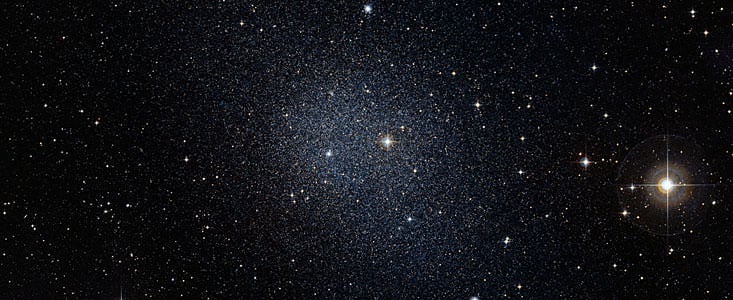[/caption]
Astronomer sleuths have solved a cosmic mystery by finding primitive stars that have been stealthily concealed. Using ESO's Very Large Telescope a group of astronomers have uncovered an important astrophysical puzzle concerning the oldest stars in our galactic neighborhood — which is crucial for our understanding of the earliest stars in the Universe. . "We have, in effect, found a flaw in the forensic methods used until now," said Else Starkenburg, lead author of a paper reporting the new findings. "Our improved approach allows us to uncover the primitive stars hidden among all the other, more common stars."
Primitive stars are thought to have formed from material forged shortly after the Big Bang, 13.7 billion years ago. They typically have less than one thousandth the amount of chemical elements heavier than hydrogen and helium found in the Sun and are called "extremely metal-poor stars." They belong to one of the first generations of stars in the nearby Universe. Such stars are extremely rare and mainly observed in the Milky Way. [caption id="attachment_56409" align="aligncenter" width="320" caption="The Sculptor dwarf galaxy is one of our Milky Way's neighbouring dwarf galaxies. Credit: ESO/Digitized Sky Survey 2"]
[/caption] Cosmologists think that larger galaxies like the Milky Way formed from the merger of smaller galaxies. Our Milky Way's population of extremely metal-poor or "primitive" stars should already have been present in the dwarf galaxies from which it formed, and similar populations should be present in other dwarf galaxies. "So far, evidence for them has been scarce," said co-author Giuseppina Battaglia. "Large surveys conducted in the last few years kept showing that the most ancient populations of stars in the Milky Way and dwarf galaxies did not match, which was not at all expected from cosmological models."
Element abundances are measured from spectra, which provide the chemical fingerprints of stars. The Dwarf galaxies Abundances and Radial-velocities Team used the FLAMES instrument on ESO's Very Large Telescope to measure the spectra of over 2000 individual giant stars in four of our galactic neighbors, the Fornax, Sculptor, Sextans and Carina dwarf galaxies. Since the dwarf galaxies are typically 300,000 light years away — which is about three times the size of our Milky Way — only strong features in the spectrum could be measured, like a vague, smeared fingerprint. The team found that none of their large collection of spectral fingerprints actually seemed to belong to the class of stars they were after, the rare, extremely metal-poor stars found in the Milky Way.
The team of astronomers around Starkenburg has now shed new light on the problem through careful comparison of spectra to computer-based models. They found that only subtle differences distinguish the chemical fingerprint of a normal metal-poor star from that of an extremely metal-poor star, explaining why previous methods did not succeed in making the identification.
The astronomers also confirmed the almost pristine status of several extremely metal-poor stars thanks to much more detailed spectra obtained with the UVES instrument on ESO's Very Large Telescope. "Compared to the vague fingerprints we had before, this would be as if we looked at the fingerprint through a microscope," explains team member Vanessa Hill. "Unfortunately, just a small number of stars can be observed this way because it is very time consuming."
"Among the new extremely metal-poor stars discovered in these dwarf galaxies, three have a relative amount of heavy chemical elements between only 1/3000 and 1/10 000 of what is observed in our Sun, including the current record holder of the most primitive star found outside the Milky Way," said team member Martin Tafelmeyer.
"Not only has our work revealed some of the very interesting, first stars in these galaxies, but it also provides a new, powerful technique to uncover more such stars," concluded Starkenburg. "From now on there is no place left to hide!"
Source:
ESO
 Universe Today
Universe Today
